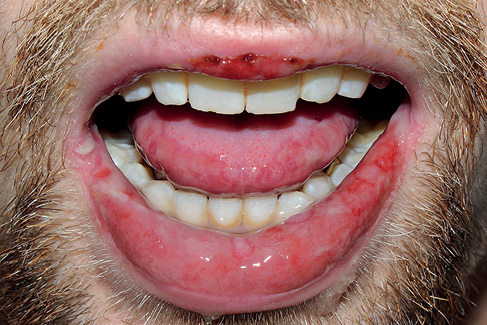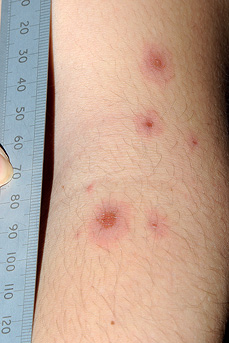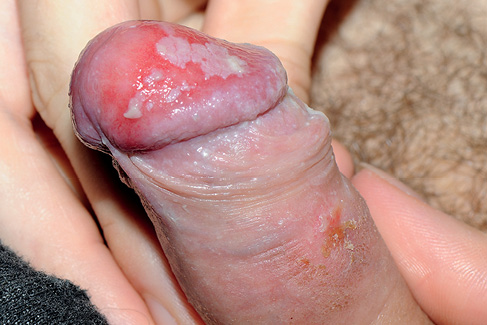A 23-year-old man presented to the Emergency Department with multiple painful mouth ulcers of almost two weeks’ duration. He only considered attending when he could not eat or drink, as a result of pain, and had to live on soup for a few days. He is normally well and fit, on no medications and has no known allergies. He also denied having any herbal or over-the-counter medications prior to or during his illness. He recalled having a high temperature for a few hours, following which he started developing the mouth ulcers (Figures 1 and 2). He also developed a rash on his arms and legs (Figures 3 and 4) as well as redness and soreness on his glans penis (Figure 5). Throughout all this he denied any headache, cough, breathlessness, aches and pains. On examination he was apyrexial. He was unable to communicate due to oral pain (his father was providing the history), excessively drooling, had no conjunctival injection and had bilateral palpable small cervical lymph nodes. Local examination of the mouth showed diffuse ulceration, with some haemorrhagic areas in the upper lips, tongue and posterior pharynx. His tongue was tender but not swollen. The glans penis was red with whitish exudate. His arms and legs showed lesions consistent with erythema multiforme (EM). The rest of the clinical examination was entirely normal.
Figure 1 Lip/mouth (cheilitis, stomatitis) diffuse oral ulcerations, haemorrhagic crusting of the vermillion zone of the lips

Figure 2 Tongue vesicles, some showing evidence of targets
Figure 3 Left arm close zoom: multiple skin lesions showing erythematous macules, with rounded, circinate erythema (target lesions)

Figure 4 Left arm target lesions
Figure 5 Diffuse genital erosions and ulceration of the penile shaft and glans, with crusts

Investigation of the full blood count (FBC) was normal with low to normal
lymphocytes count. C-reactive protein (CRP) was 14. Serum creatinine was high at 144µmol/L (59–104). GFR 59ml/min (90–200). Vasculitis screen was negative. HIV testing was negative as well as his treponemal screen. Herpes simplex virus was not detected in the buccal or glans penis ulcers. Both cytomegalovirus IgM and anti-EBV IgM were negative. However, a COVID-19 testing, carried out routinely in all patients, detected a positive result by PCR. A clinical diagnosis was made of overlap syndrome of EM and Stevens–Johnson syndrome (SJS), probably secondary to COVID-19.
The patient was managed with intravenous fluids and analgesia, with good recovery. He was followed up with a phone call and confirmed complete resolution of his skin and buccal lesions and no developments of respiratory symptoms.
Dermatological manifestations of COVID-19 are rare and unlike other viral infections can be polymorphic with different presentations in the same patient. They can involve any part of the body, both sexes and all age groups. However, mucosal involvement is very rarely reported. In one reported case the mucosal involvement was a herpes simplex virus-1 reactivation in an intubated COVID-19 patient rather than a direct presentation of the virus.1 In two other cases of SJ syndrome, one was attributed to hydroxychloroquine2 and the other was in a COVID-19 positive immunosuppressed patient.3 It is probably that this case is the first EM/SJS directly related to COVID in an immune-competent young man in the absence of any respiratory symptoms.
Awareness of the polymorphic skin changes and their occurrence as a COVID-19 manifestation, even independent of respiratory symptoms, is prudent for early diagnosis and hence taking the essential preventive measures to prevent further spread of the disease.
References
1 Hedou M, Carsuzaa F, Chary E et al. Comment on ‘Cutaneous manifestations in COVID-19: a first perspective’ by Recalcati S. Eur Acad Dermatol Venereol ,2020; 34: e299-e300.
2 Davoodi L, Jafarpour H, Kazeminejad A et al. Hydroxychloroquine-induced Stevens–Johnson syndrome in COVID-19: a rare case report. Oxf Med Case Reports 2020; 6: 193–195.
3 Lagziel T, Quiroga L, Ramos M et al. Two false negative test results in a symptomatic patient with a confirmed case of severe acute respiratory syndrome coronavirus-2 (SARS-CoV-2) and suspected Stevens–Johnson syndrome/toxic epidermal necrolysis (SJS/TEN). Cureus 2020; 12: e8198.
